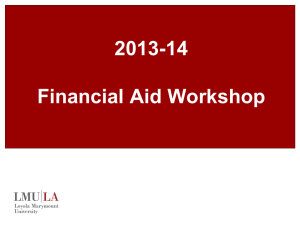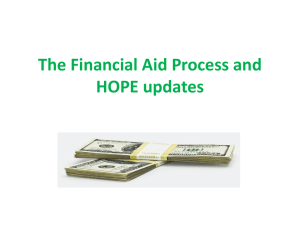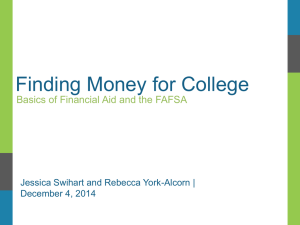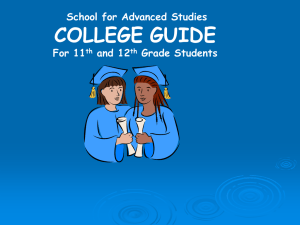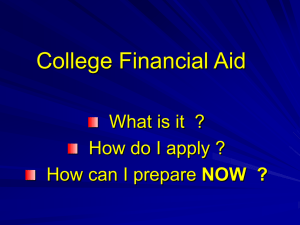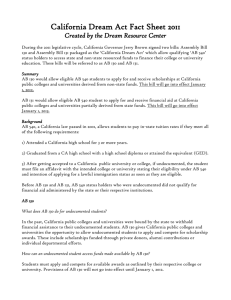2013-14 CFC - Fairfax Senior High School
advertisement
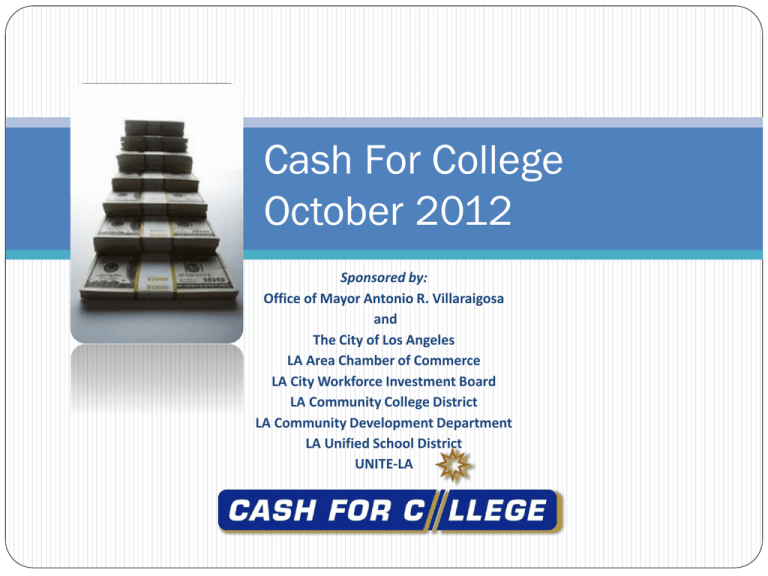
Cash For College October 2012 Sponsored by: Office of Mayor Antonio R. Villaraigosa and The City of Los Angeles LA Area Chamber of Commerce LA City Workforce Investment Board LA Community College District LA Community Development Department LA Unified School District UNITE-LA Why Are You Here? College is critical to your future Jobs of the future will require more skills than those provided by a high school education alone Students who go to college have financial advantages their life-time earnings are higher than those of high school graduates they are less likely to be unemployed their children are more likely to attend college 2 Who Wants A Million Dollars? 3 Workshop Agenda The financial aid equation Who gets the money? Types of financial aid – Grants Scholarships Work Loans How to apply for financial aid Free scholarship searches 4 What Financial Aid Offers? Access to funds to help pay for 4-year public and independent colleges and universities Community colleges Private career colleges Choice among schools Choose the best academic, career, cultural, and social fit rather than the least expensive program 5 What Are The Basic Concepts Of Financial Aid? Student Cost of Attendance Parent and Student Expected Family Contribution Student Financial Need 6 The Costs Of Going To College Tuition & Fees Books & Supplies Room & Board Personal Expenses Transportation 7 What Is The Expected Family Contribution? The Expected Family Contribution (EFC) is the amount a family (parents and student) is expected to contribute from income and assets over time 8 What Is Financial Need? Cost of Attendance - Expected Family Contribution Financial Need* *Financial Need equals Financial Aid Eligibility 9 What Are The Major Types Of Financial Aid Funding? Gift Aid - Grants or scholarships that do not need to be repaid Work - Money earned by the student as payment for a job on or off campus Loans - Borrowed money to be paid back, usually with interest 10 What Are The Primary Sources Of Financial Aid? Federal government State governments Colleges and universities Private agencies and organizations 11 How The Formula Works Cost EFC Need CC CSU UC Independent $13,000 - 500 $12,500 $23,000 - 500 $22,500 $31,000 - 500 $30,500 $55,000 - 500 $54,500 In the best of all possible worlds, full “need” will be met with financial aid award made up of grants and scholarships along with reasonable amounts of work and loan. Some schools are not able to meet full need. 12 Financial Aid Awards After you are admitted to one or more colleges or universities and your financial aid application is complete, the Financial Aid Office at each school will provide a: Financial Aid Award Letter that contains details on the types and amounts of aid such as grants, work-study, and lowinterest loans the college is offering You and your family should then: compare the awards you are offered to the costs of the college that made the offer compare the amount of loans offered by each college or university decide whether you should borrow or if you and your family should pay the loan amount from your own resources 13 How Students Apply For Financial Aid In 2013-2014 FAFSA (Free Application for Federal Student Aid) www.fafsa.ed.gov Cal Grant GPA Verification Form Some colleges may request: CSS/Financial Aid PROFILE www.collegeboard.com 2012 parent and student IRS Federal Tax Returns (including all schedules and W-2 forms) or other income documentation, such as IRS Federal Tax Transcripts Other required forms 14 Apply For A PIN To File FAFSA On The Web Federal PIN (Personal Identification Number) serves as the electronic signature on the FAFSA and other federal aid documents Student and at least one custodial parent need a PIN May also be used to: Check on FAFSA status Verify FAFSA data Make FAFSA Corrections on the Web Reapply for financial aid in future years Apply NOW for your PIN at: www.pin.ed.gov 15 2013-2014 Cal Grant Entitlement Programs By March 2, 2013, complete and submit: the FAFSA the Cal Grant GPA Verification Form Check with your school for more details 16 2013-2014 Cal Grant A Entitlement All students who have earned a high school GPA of 3.0 or greater, demonstrate financial need, meet parental income and asset requirements, and file by March 2, 2013 will receive up to four years of system-wide fees at UC ($12,192) and CSU ($5,970) campuses as much as $9,084 at independent California colleges or universities as much as $4,000 at California private career colleges 17 2013-2014 Cal Grant B Entitlement All students who have earned a high school GPA of 2.0 or greater, demonstrate financial need, meet parental income and asset requirements, and file by March 2, 2013 will receive up to four years of a $1,473 stipend for living expenses for up to four years at all California colleges and universities including the community colleges plus system-wide fees at UC ($12,192) and CSU ($5,970) campuses for second through fourth years as much as $9,084 at independent California colleges or universities for second through fourth years as much as $4,000 at California private career colleges 18 Community College Fee Waiver The California Community College Board of Governors’ Enrollment Fee Waiver (BOG Fee Waiver) covers the California Community College enrollment fee for California residents: who are eligible for need-based financial aid, or who receive CalWORKs/TANF, SSI, or General Assistance payments, or whose family income falls below published income ceilings Learn more about the BOG Fee Waiver at www.icanaffordcollege.com 19 California Chafee Grant For Foster Youth The California Chafee Grant program provides up to $5,000 annually to current and former foster youth for college or vocational training at any accredited college in the U.S. To be eligible, the foster youth must have been in California foster care on his or her 16th birthday and not have reached his or her 22nd birthday before July 1, 2013 To apply, complete the: 2013-2014 FAFSA California Chafee Grant Program Application To learn more about the Chafee Grant, go to www.chafee.csac.ca.gov 20 Useful Websites www.studentaid.ed.gov www.fafsa4caster.ed.gov www.finaid.org www.collegeboard.com www.fastweb.com www.scholarshipsearchsecrets.com These sites contain useful financial aid and scholarship information 21 Scholarships Use FREE Scholarship Searches Available from colleges, companies, community based groups and other agencies and organizations Usually require separate applications May require transcript, essay, interview, or audition Check with your high school, college or university about other scholarship opportunities Beware of scholarship search companies that charge a fee 22 Don’t Be Fooled! Beware of false claims! “Thousands of dollars in scholarships go unclaimed each year” “Guaranteed or your money back!” “Give me your credit card or bank account number to hold this scholarship” “The scholarship will cost some money” “You’ve been selected. . .” “You’re a finalist in a contest” (that you never entered) 23 Sample Scholarship Application Questions Contact data: name and address of student Demographics: birth date, gender, race, heritage, religion, marital status, citizenship, disabilities parent employer, education, and veteran status Education, work, and activities: high school and colleges attended, year in school, GPA, SAT/ACT scores, community service and employment history student sports, hobbies, special talents/skills, and other interests 24 Gates Millennium Scholarship (GMS) Funded by the Bill and Melinda Gates Foundation Minimum 3.3 high school GPA African American, Asian, Hispanic or Native American students who are Federal Pell Grant eligible and will be first year college students Application deadlines January 16, 2013 – online GMSP Application by 11:59 PM EST January 16, 2013 – postmark date for application materials February 15, 2013 – deadline to submit FAFSA Renewable for all undergraduate study and graduate work in designated fields Maintain minimum cumulative college GPA of 3.0 Continue to demonstrate financial need Meet renewal deadlines Application and more information available at www.gmsp.org 25 Undocumented Students Undocumented and under-documented students, while not eligible for federal aid, may be eligible for state aid in California start inquiring in elementary and high school to see if it is possible for the student to become a permanent resident apply for all scholarships for which the student may be eligible check with colleges and universities to see if institutional financial aid is available watch for changes in federal and state laws regarding the eligibility of undocumented or under-documented students for more information: call (213) For a list of scholarships, go to 629-2512 www.maldef.org/assets/pdf/MALDEF_Scholarship_Resource_Guide.pdf and www.latinocollegedollars.org 26 Undocumented Students Undocumented students should take note of the following California state laws: AB 540 - allows undocumented students to qualify for in-state tuition at California public colleges and universities if the student attended an accredited California high school for at least three years; and graduated, or will graduate, for an accredited California high school; or have attained a G.E.D. AB 130 - allows AB 540 eligible student to apply for non-state funded scholarships for California colleges and universities AB 131 - allows AB 540 eligible students to apply for state funded financial aid, e.g., Cal Grants, effective January 1, 2013 for the 2013-2014 academic year 27 Before Deciding On A College Make a list of colleges and universities that have programs of interest to you Consult with your school counselor If possible, don’t make a final decision about which school you will attend until you have visited the colleges and universities Consider all factors – not just cost – when making the final decision 28 Get Cash for College… Participate in all college information sessions at your high school Attend a Cash for College FAFSA Workshop on Saturday, January 26, 2013 for help completing the FAFSA and the Cal Grant GPA Verification Form (both due by March 2, 2013) a chance to win one of many scholarships To find a location close to you, visit: www.lacashforcollege.org 29 30
